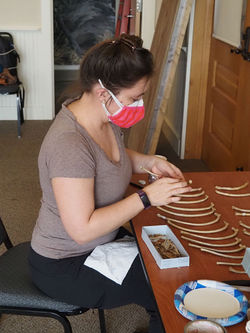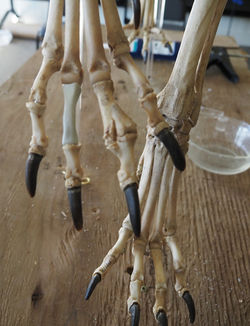
TheBoneman.com
Bone Building Books
Step-by-Step Guides for the Preparation and Articulation of Animal Skeletons
By Lee Post (a.k.a. Boneman)
Montana Wolf Skeleton Project
The Skeletal Articulation of Wolf #302


 |  |
|---|---|
 |  |
 |  |
Wolf 302 Gardiner Montana , Feb 14 - Feb 19 - 2022
In November of 2020, I was contacted by Miriam Watson from Gardiner Montana to see if I would be interested in articulating a wolf skeleton for Yellowstone National Park. She wanted to know the usual.
-
What would it cost?
-
How long would it take?
-
What materials would be needed?
I sent her a detailed materials list, and gave her an estimate of it being a six-day project, which we cut down to five days. I told her my interest of having some of her people work on it, if they were interested, warning her it wouldn't necessarily be any faster but they would probably have a great week doing some hands-on work.
Over the next couple of years, I heard about the project from time to time in the form of E-mail questions. I discovered this town was on the edge of Yellowstone National Park, and the nearest full hardware store was probably in Bozeman, eighty miles away. A few months before the scheduled articulation I asked for some photos of the bones to make sure they looked ready to assemble. I got a couple of photos of what looked like bags of bone chips that had been collected from an archaeological site. There was nothing in the bags that was big enough or obvious enough to know what they even were. This was a deal-killer if these were the bones we would be working with. It turned out they were chips and pieces, some of which came from the wolf's stomach. The rest of the bone pictures came the next day and they looked more like full wolf bones. The skull looked to be from a worn out old wolf. The rest of the bones looked reasonable. Over the next few weeks around Christmas of 2021, we nailed down the details.
-
Where I would be staying?
-
Would I be allowed to work late?
-
Was there food in town?
-
How I would get there?
-
How many people are helping?
-
What did I need in the work-room?
Most of my bone work has been with Marine Mammals. A major advantage of working with these is they are swimming animals and can be built as if they are swimming through water. On a land mammal, it is critical to know exactly where and how much bend each leg and foot has if it is going to be accurate. I've done a lot of land mammals but only one other wolf which was a similar project done with school students for Denali National Park. That one was of a wolf in its prime who was trapped outside of the Park. The bones were in perfect condition and were solid and unbroken. By comparison, the Montana wolf bones were from an old animal, many had been broken in life and had healed and many more had broken when the wolf was killed. There had been a lot of reabsorption of bone in the skeleton, leaving bones like the vertebrae being exceptionally delicate and hollow inside. This was a challenge to figure out how to attach the ribs to the vertebrae. A hole drilled in, for rib attachment, exposed sometimes totally hollow bones with an extremely thin bone layer on the outside. One fibula had been broken in possibly two places and healed with an improbable twist to it. The rib cage on one side had an asymmetrical concavity to it, as if in its youth the whole side of the rib cage had been kicked in and healed. Many of the ribs had broken and healed. Other ribs had broken in his final fight. One tail vertebra had been broken in half and healed at 45 degree angle. The pelvis to sacrum angle was off. Various bones had indications of having been bitten or damaged or infected over its life. A front phalange bone had fused with another and the following phalanx had spread out and articulated with both phalanges. This left a question of what the next digit was doing with its missing bones to hold the terminal phalanx on. Many of the lumbar vertebrae had broken or missing dorsal and lateral processes. This animal had a long tough life.
It was only as I was leaving Alaska that I grabbed a book, The Rise of Wolf 8 by Rick McIntyre, and realized what dramatic lives these Yellowstone wolves live. Then I started hearing more and more stories about this wolf - Wolf 302 AKA Casanova, “He was a lover, not a fighter.” I learned that he is probably the most well known wolf in America. He even has his own Wikipedia page! And he has a whole book written about him, The Redemption of Wolf 302, also by Rick McIntyre. Wolf 302 was also the subject of a couple major television documentaries. One by Nature and one by National Geographic. People that I was working with were either museum professionals or Wolf Biologist/Technicians who knew this wolf well. I had stepped into a world where wolf-talk was the norm. Wolf 302 was possibly the oldest and most famous wolf to come out of the Yellowstone National Park wolf reintroduction project. He was killed in 2008 by other wolves at the age of nine and one half years.
There I was with a crew of wolf experts and museum people trying to reconstruct this extremely fragile skeleton in a five-day period such that it would honor the wolf and be accurate and displayable. A fellow Alaskan, who I've done a number of large skeleton projects with, (Marc Swanson from Seward), just happened to be in the neighborhood and stopped in on Monday. I put him to work that day and he forgot to leave and stayed till Friday. Turns out he grew up in one of the next towns over and Gardiner was his old stomping grounds. With his help, we got the body section done. The rib cage was asymmetrical with bent and twisted ribs. The vertebrae were so soft and hollow that the torso was a major challenge.
About the time the legs were about done, a fellow (George Bumann) came in one evening who had articulated a coyote skeleton and was a sculptor of wildlife. He had measured multiple dead wolves to get accurate proportions and was planning on possibly doing a sculpture of this very wolf; he was quite interested in it being accurate. He looked at what we had done and wasn't convinced the pelvis was right and had questions about the bends of the legs and the proportions and bend of the sternum and rib cage. He was going to go home and eat and bring his notes back. I was dreading that he would conclude we had it all wrong. Then what would it take to re-position all that had been done. He came back later with all kinds of materials on the proportions of the body of wolves from this area. After looking at the pelvis to sacrum connections, it still didn't look right to him but he didn't see anywhere it could fit differently. The wolf pathologist, Dr. Sue Ware. who had cleaned the bones of this wolf, explained that the pelvis was janky - a function of a long hard life. Some of the measurements I took best guesses on; the length of the sternum, the size of the rib cage, and the forward/back placement of the ribs. These ended up being very close to right on. George looked at the legs closer and placed them on the wolf as he thought they should go and we marked how they went such that we could permanently attach them. Wolf 302 is in a natural trot pose. I never would have gotten that part right on my own. George should have been working on the project the whole time.
The final day, Marc had left and I was down to two helpers, and a documentary film crew wanting to film us in the final assembly. We got the legs placed thanks to Georges help. Got supports in place for each of the legs and a couple acrylic supports to hold the body. These were all drilled into a plywood base such that it can be copied in a final display stand at a later time. Miriam and Sara from the museum helped me all day and came back after dinner to help me finish up the head support and the leg attachments. I stayed late and got it mostly finished and the area cleaned up. Next morning, a few more touch-ups and wolf skeleton got its UDD - (unilateral declaration of doneness). On hindsight, had I known how old and famous this wolf was, how broken and delicate the bones were, how important this individual wolf was to the people of the Park, I never would have had it be a five day project. It should have been an eight day project or so. I would have wanted to have George Bumann right from the start. I would have also been rather nervous that this was the first bone project the crew of five local helpers was working on. They did great. Marc was a huge help.
Casanova is in motion again. We fixed what we could and got him back together. Except he lost his baculum. There were a lot of conversations about that missing bone, especially for this wolf of all wolves.
The Players Involved in this Wolf Skeleton Project Were:
-
Miriam Watson - Curator of the Yellowstone Heritage and Research Center
-
Sara - Museum Intern
-
Maddy Jackson - Technician Wolf Project
-
Erin Stahler - Wolf Biologist
-
Mary Morgan - Super Helper
-
George Bumann - Artist and Savior at a Perfect Time
-
Kimberley Guidone - Film Person from Vermont
-
Bob Landis - Cinematographer
-
Brian Gerber - Yellowstone Forever Host/Director
-
Dennis - The Tool/Materials Go-to-Guy
-
Sue Ware - Cleaning and Analyzing the Bones Person
-
Me - The Boneman from Homer, Alaska
-
Wolf 302, #Yell - 199478